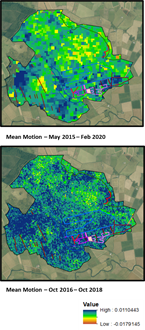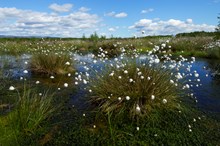25 July, 2021
Satellites track “bog breathing” to help monitor peatlands

Using satellite technology to look at how bogs “breath” could help build a better picture of peatland condition and restoration progress in Scotland.
New research, published on International Bog Day (July 25th), demonstrates the potential for measuring “bog breathing” - or peatland surface motion – to monitor restoration sites in future.
A collaboration between NatureScot, University of the Highlands and Islands, University of Nottingham, and Forestry and Land Scotland, the research uses Satellite Interferometric Synthetic Aperture Radar (InSAR), which can map the movement of the ground’s surface – a technique developed with University of Nottingham spinout company Terra Motion Ltd.
The way that bogs move, or breathe, can be influenced by many factors, including precipitation, water level, vegetation composition, micro-topography and land management.
By measuring the motion over time, the technique is able to assess the condition of the peatland and the effectiveness of different restoration techniques on a large-scale.
If developed on a national-scale, the method could provide a better estimate of the amount, distribution, condition and associated carbon inventories of peatlands in Scotland, and a means of assessing the impact of investment in peatland restoration.
It could also help to identify areas at high-risk of peat instability, fire and erosion, and highlight where urgent restoration action might be needed.
May Shirkhorshidi, NatureScot’s Peatland ACTION report manager, said: “Peatland restoration is a crucial nature-based solution to the twin crises of climate change and biodiversity loss, a key priority as we look towards the COP26 in Glasgow later this year.
“While in the early stages of development, we are excited about the long-term potential of this research, which could help Peatland ACTION to target priority areas for restoration and offer a scientifically-proven way of monitoring changes in peatland condition following restoration.
“This is a really interesting development for all the Peatland ACTION partners as it could help us evaluate the success of different restoration techniques - putting us in a better position to share this knowledge with others. Crucially it could allow us to do this more quickly and on a far larger scale across Scotland. We look forward to working with partners over the coming years to develop the concept further."
Lead author Chris Marshall conducted the research while at Nottingham and subsequently with the Environmental Research Institute at North Highland College UHI, part of the University of the Highlands and Islands, where he is now a peatland scientist.
He said: “Bog breathing or peat surface motion gives a unique insight into the inner workings of the peatland including its landscape, hydrology and ecology, however the high frequency of ESA sentinel-1 imagery and developments in InSAR processing techniques allows us to monitor peatland condition at a scale unimaginable a decade ago allowing peatland restoration progress to be measured in real time.
“The techniques developed during this work are now being applied as part of a Leverhulme award to determine how resilient the Scotland’s peatlands are to extreme climate events such as wildfire, drought and extreme precipitation events, in order to guide management of these valuable ecosystems during this period of climatic change.”
David Large, co-author and peatland specialist at the University of Nottingham, said: "This new tool allows us to see the landscape swell and contract in response to different environmental conditions. A healthy peatland is wet with lots of soft and spongy sphagnum mosses that swell and retain water. In contrast, drier peatlands are stiffer and unresponsive to the addition of water. The former moves like a beating heart, whereas a degraded peatland could be described as flatlining!
“This technique is really exciting because it enhances our understanding of peatlands, allowing us to see what we would not ordinarily be able to with the naked eye, making our peatlands more accessible and ensuring restoration takes place in the right place. In the future, it has the potential to be used to monitor carbon emissions.”
ENDS
Contact information
- Name
- NatureScot Media
- Telephone
- 0131 316 2655
- media@nature.scot
Notes to editors
For a copy of the full report please email MEDIA@nature.scot
Case study - NatureScot’s Flanders Moss National Nature Reserve (NNR) was one of the 10 focus sites featured in the report. The raised bog in west Stirlingshire is one of the largest remaining intact peat bogs in Britain. The research found that overall Flanders Moss appears to show long term peatland surface motion comparable with stable ‘near natural’ sites illustrating the positive impact of peatland restoration measures.
Peatland ACTION Fund
About the project
The focus of Peatland ACTION is to restore damaged peatlands in Scotland for the many benefits to both people and nature.
Where does Peatland ACTION funding come from?
Peatland ACTION Funding comes through the Scottish Government’s Climate Change Plan to net zero, which last year (2020) set out a commitment to invest £250 million over 10 years to support the restoration of at least 20,000 ha of Scottish peatlands annually, towards a total of 250,000 hectares by 2030.
Who are the Peatland ACTION Delivery Partners?
Peatland ACTION Funding is delivered through a network of partner organisations including NatureScot, Scottish Water, Forest and Land Scotland, Loch Lomond and the Trossachs National Park Authority and Cairngorms National Park Authority.
Further information about the work of Peatland ACTION and restoration funding from NatureScot: www.nature.scot/peatlandaction
The University of the Highlands and Islands is a regional tertiary university partnership, serving the communities of the Highlands and Islands, Moray and Perthshire. We cover the largest geographical area of any campus-based university or college in the UK and have one of the largest student populations in Scotland, with over 35,000 studying with us each year. Our students can study at both further and higher education levels on a wide range of vocational and academic courses and our research is focussed on the social, cultural and economic needs of our communities.
The University of Nottingham is a research-intensive university with a proud heritage. Studying at the University of Nottingham is a life-changing experience, and we pride ourselves on unlocking the potential of our students. We have a pioneering spirit, expressed in the vision of our founder Sir Jesse Boot, which has seen us lead the way in establishing campuses in China and Malaysia - part of a globally connected network of education, research and industrial engagement. Ranked 103rd out of more than 1,000 institutions globally and 18th in the UK by the QS World University Rankings 2022, the University’s state-of-the-art facilities and inclusive and disability sport provision is reflected in its crowning as The Times and Sunday Times Good University Guide Sports University of the Year twice in three years, most recently in 2021.
NatureScot is Scotland's nature agency. We work to enhance our natural environment in Scotland and inspire everyone to care more about it. Our priority is a nature-rich future for Scotland and an effective response to the climate emergency. For more information, visit our website at www.nature.scot or follow us on X at https://x.com/NatureScot
’S e NatureScot buidheann nàdair na h-Alba. Bidh sinn a’ neartachadh àrainneachd na h-Alba agus a’ brosnachadh dhaoine gu barrachd suim a chur ann an nàdar. Tha e mar phrìomhachas againn gum bi nàdar na h-Alba beairteach agus gun dèilig sinn gu h-èifeachdach le èiginn na gnàth-shìde. Tha an tuilleadh fiosrachaidh aig www.nature.scot no air X aig https://x.com/NatureScot
Downloads

Long term trends in peat surface motion at Flanders Moss NNR. Top image showing 5 years of data at 80m pixel resolution. Bottom showing 2 years of data at 20m pixel resolution. Lines show restoration activities. ©Nottingham University. Contains NatureScot data and basemap data from ©Getmapping Plc Contains OS data ©Crown copyright and database right (2020)



